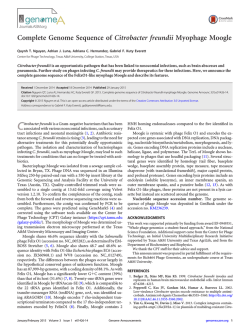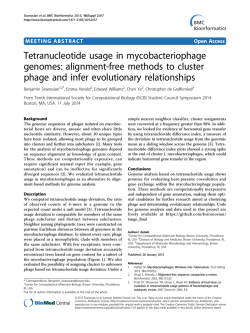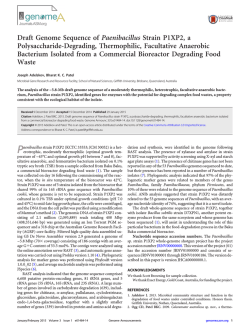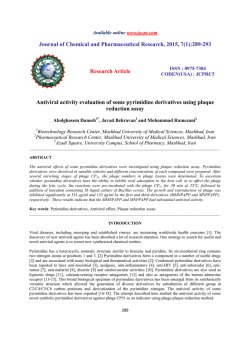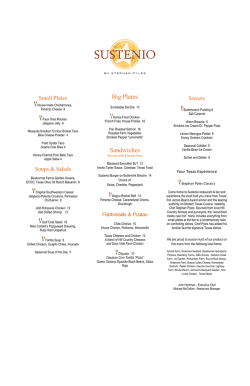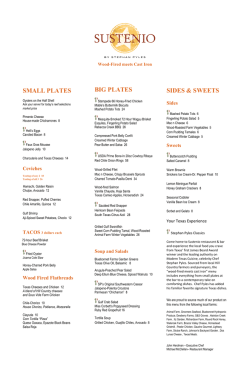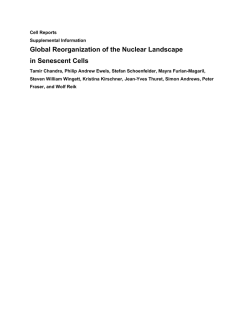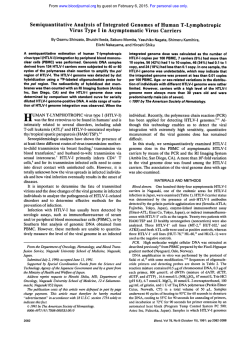
Complete Genome of Bacillus megaterium Podophage Pookie
crossmark Complete Genome of Bacillus megaterium Podophage Pookie Tsonyake N. Ladzekpo, Andrew J. DeCrescenzo, Adriana C. Hernandez, Gabriel F. Kuty Everett Center for Phage Technology, Texas A&M University, College Station, Texas, USA Bacteriophage Pookie is a novel podophage, isolated from soil, which infects Bacillus megaterium. B. megaterium is an important host for large-scale recombinant protein production. Here, we present the complete genome of phage Pookie and describe its core features. Received 1 December 2014 Accepted 19 December 2014 Published 29 January 2015 Citation Ladzekpo TN, DeCrescenzo AJ, Hernandez AC, Kuty Everett GF. 2015. Complete genome of Bacillus megaterium podophage Pookie. Genome Announc 3(1):e0143214. doi:10.1128/genomeA.01432-14. Copyright © 2015 Ladzekpo et al. This is an open-access article distributed under the terms of the Creative Commons Attribution 3.0 Unported license. Address correspondence to Gabriel F. Kuty Everett, [email protected]. B acillus megaterium is a Gram-positive bacteria widely used in industry due to its efficient protein secretion system and ability to grow on various inexpensive carbon sources (1). Additionally, it is nonpathogenic and lacks endotoxins (2). Bacteriophages infecting B. megaterium are readily found in the environment and may be able to provide biotechnological advances. With that in mind, we describe here the genome of novel B. megaterium podophage Pookie. Bacteriophage Pookie was isolated from a soil sample collected in College Station, TX. Phage DNA was sequenced in an Illumina MiSeq 250-bp paired-end run with a 550-bp insert library at the Genomic Sequencing and Analysis Facility at the University of Texas (Austin, TX). Quality-controlled trimmed reads were assembled to a single contig at 67.3 fold coverage using Velvet version 1.2.10. The contig was confirmed to be complete by PCR using primers that face the upstream and downstream ends of the phage DNA. Products from the PCR amplification of the junctions of concatemeric molecules were sequenced by Sanger sequencing (Eton Bioscience, San Diego, CA). Genes were predicted using GeneMarkS (3) and corrected using software tools available on the Center for Phage Technology (CPT) Galaxy instance (https://cpt.tamu.edu/galaxy-public/). Morphology was determined using transmission electron microscopy performed at the Texas A&M University Microscopy and Imaging Center. Pookie has a 40,214-bp genome with a GϩC content of 40.57%. It has a coding density of 96.6% and encodes 52 predicted coding sequences. Pookie shares 89.6% nucleotide sequence identity to B. megaterium podophage Pony (NC_022770) according to an Emboss stretcher analysis (3). Pookie has a limited host range and infects B. megaterium Km Sp-. Genes encoding proteins necessary for phage replication, morphology, gene regulation, and lysis were identified. Replication and recombination proteins include ssDNA-annealing (RecTlike) and binding proteins, a DnaC-like replication protein, a DnaB/DnaD-like replication protein (IPR006343) (4), and a plasmid replication/relaxation protein. Pookie also encodes two proteins containing lambda CI and Cro-like helix-turn-helix DNA-binding domains (IPR001387). The plasmid replication/relaxation protein and repressor-like DNA-binding proteins may suggest that Pookie may be a temperate phage that exists as a January/February 2015 Volume 3 Issue 1 e01432-14 plasmid-borne lysogen. Few morphogenesis proteins were identified and include a capsid protein, tailspike, and tail fiber. The capsid protein was predicted using the HHpred server for protein homology detection and structure prediction (5). To accomplish DNA packaging, Pookie encodes large and small terminase subunits and a head-to-tail joining (portal) protein. Large terminase homology suggests that Pookie packages its DNA in a pac headful mechanism. As a pac-type phage, the circularly permuted genome of Pookie was opened to the small terminase gene by precedent (6). The genes which affect lysis encode a holin, anti-holin, and an endopeptidase endolysin. Pookie also codes for a SpoIIIE-like protein. SpoIIIE is responsible for packing DNA into the forespore in sporulating cells, but its role in phage infection has not been studied (7). Nucleotide sequence accession number. The genome sequence of phage Pookie was contributed to GenBank under the accession no. KM236248. ACKNOWLEDGMENTS This work was supported primarily by funding from award EF-0949351, “Whole Phage Genomics: A Student-Based Approach,” from the National Science Foundation. Additional support came from the Center for Phage Technology, an Initial University Multidisciplinary Research Initiative supported by Texas A&M University and Texas AgriLife, and from the Department of Biochemistry and Biophysics. We are grateful for the advice and support of the CPT staff. This announcement was prepared in partial fulfillment of the requirements for Bich464 Phage Genomics, an undergraduate course at Texas A&M University. REFERENCES 1. Korneli C, David F, Biedendieck R, Jahn D, Wittmann C. 2013. Getting the big beast to work—systems biotechnology of Bacillus megaterium for novel high-value proteins. J Biotechnol 163:87–96. http://dx.doi.org/ 10.1016/j.jbiotec.2012.06.018. 2. Eppinger M, Bunk B, Johns MA, Edirisinghe JN, Kutumbaka KK, Koenig SS, Creasy HH, Rosovitz MJ, Riley DR, Daugherty S, Martin M, Elbourne LD, Paulsen I, Biedendieck R, Braun C, Grayburn S, Dhingra S, Lukyanchuk V, Ball B, Ul-Qamar R, Seibel J, Bremer E, Jahn D, Ravel J, Vary PS. 2011. Genome sequences of the biotechnologically important Bacillus megaterium strains QM B1551 and DSM319. J Bacteriol 193: 4199 – 4213. http://dx.doi.org/10.1128/JB.00449-11. 3. Myers EW, Miller W. 1988. Optimal alignments in linear space. Comput Appl Biosci 4:11–17. http://dx.doi.org/10.1093/bioinformatics/4.1.11. Genome Announcements genomea.asm.org 1 Ladzekpo et al. 4. Bruand C, Farache M, McGovern S, Ehrlich SD, Polard P. 2001. DnaB, DnaD and DnaI proteins are components of the Bacillus subtilis replication restart primosome. Mol Microbiol 42:245–255. http://dx.doi.org/10.1046/ j.1365-2958.2001.02631.x. 5. Söding J, Biegert A, Lupas AN. 2005. The HHpred interactive server for protein homology detection and structure prediction. Nucleic Acids Res 33:W244 –W248. http://dx.doi.org/10.1093/nar/gki408. 2 genomea.asm.org 6. Casjens SR, Gilcrease EB. 2009. Determining DNA packaging strategy by analysis of the termini of the chromosomes in tailed-bacteriophage virions. Methods Mol Biol 502:91–111. http://dx.doi.org/10.1007/978-1-60327-565-1_7. 7. Burton BM, Marquis KA, Sullivan NL, Rapoport TA, Rudner DZ. 2007. The ATPase SpoIIIE transports DNA across fused septal membranes during sporulation in Bacillus subtilis. Cell 131:1301–1312. http://dx.doi.org/ 10.1016/j.cell.2007.11.009. Genome Announcements January/February 2015 Volume 3 Issue 1 e01432-14
© Copyright 2025
